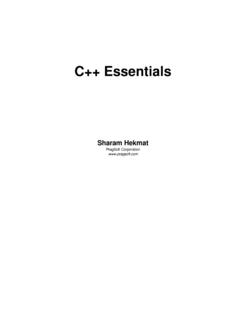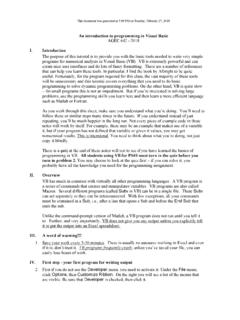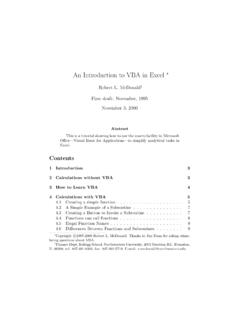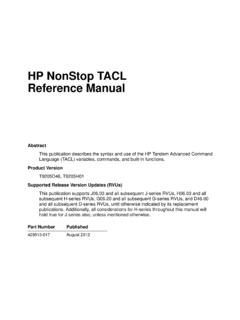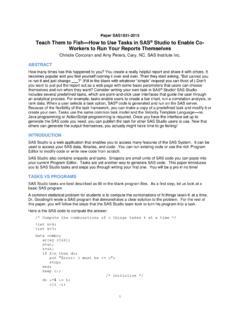Transcription of 070-29: ARRAY: Construction and Usage of Arrays …
1 Paper 070-29 array : Construction and Usage of Arrays of macro VariablesRonald FehdCenters for Disease Control, and Prevention, Atlanta GA USAABSTRACTThe SASR software data step statementarray V (3) $ V1-V3 ( A B C );produces three charactervariables named V1, V2, and V3 with corresponding initial values, A , B , and C and a function,dim(V)whichreturns a value of 3. Programmers can write simple macro tools for use in larger macro procedures. These tools canduplicate SAS software data step constructions that the programmer is comfortable using and make reading andcomprehension easier. The macro statement% array (V,A B C)produces three macro variables, V1, V2, and V3,with corresponding values: A, B, and C and macro variableDimVwith the value 3.
2 These variables can then beused in the macro iterative loop statement%Do I = 1 %to This paper examines the SAS data steparray statement and discusses the issues in constructing and using Arrays of macro variables. The macroArraytakes parameters of either a list of elements or a data array is a basic utility used in two other macros that address analysis of multiple-response data. See [3], [4].INTRODUCTIONA common task for an experienced programmer is to recognize a recurring pattern of code and encapsulate thatpattern in a routine which simplifies the processing presentation, while still enabling later readers of the program tograsp the complex concepts that have been SAS software macro language is a simple yet powerful programming language.
3 This article examines the SASsoftware array and associated do loop statements with the idea of translating those concepts into SAS softwaremacro language array STATEMENT AND THE DIMENSION (DIM) FUNCTIONThe explicit array statement in SAS software has seven phrases; we will examine the four that are most : SAS statement name: : required, either of a number or asterisk, enclosed in parenthesis (3): a number supplied for creation of a series of variables (*): asterisk indicating subscript is determined by SAS software by counting the supplied elements: an optional list of variable namesThe dimension function dim(ABC) has two the SAS function an array name defined in the same data stepA typical Usage of the array statement would consist of accessing one set of variables in order to repeat some pro-cessing on each variable .
4 The example inProgram 1below reads in three Fahrenheit temperatures and convertsthem to Celsius. Note that thePROC Contentslisting shows that SAS has created a series of variables basedon the absence of the array -elements in thearray Celsiusstatement. Their names Celsius1,Celsius2,andCelsius3 correspond to the way the variables are accessed in the iterative loop by the array convention ofCelsius(I), ,Celsius(1),Celsius(2), andCelsius(3).1 SUGI 29 Coders' CornerProgram 1 DATA Temperatures; array Celsius {3};*note no array -elements, see Contents; array Farnheit {*} Low Med Hi;drop I;input Low Med Hi;do I = 1 to dim(Farnheit); Celsius{I} = (Farnheit{I}-32) * 5/9;end;cards;*<deleted for brevity>;PROC Contents.
5 - - - SAS output: - - -# variable Type Len Pos- -------- ---- --- ---4 Celsius1 Num 8 245 Celsius2 Num 8 326 Celsius3 Num 8 403 Hi Num 8 161 Low Num 8 02 Med Num 8 8 SAS SOFTWARE macro LANGUAGE ITERATIVE LOOPTo replicate the SAS software iterative loop in the macro language we use a sequentially numbered series of macrovariables and a macro variable containing the dimension:%Let Var1 = Q04A;%Let Var2 = Q04B;%Let Var3 = Q04C;%Let Dim_Var = 3;The macro iterative loop and Usage of the macro variables can then be written in a form that is visually similar to theSAS software iterative I = 1 %to %Put Var&I.
6 :: %end;This loop writes the following note to the SAS log:Var1 :: Q04 AVar2 :: Q04 BVar3 :: Q04 CThis is a Construction used regularly in certain types of macros. The purpose of this paper is to construct a macrothat supports this iterative loop. Such a macro would be namedArray, and would have two of the SAS arraystatement phases as parameters: array name, and array -element values. This macro would return a sequentially-numbered series of macro variables and the dimension of the array . The array -element values could be either aprovided list or the values of a variable in a data set. This second option of providing the array -element values ina data set would enable macro procedures to be completely data-driven.
7 Awhereparameter has been added tofacilitate subsetting of data sets used as parameters. See [3], [4] for AND CONSTRAINTSThe simplicity of the macro language both allows and requires Construction of a routine that has the appearanceof the SAS softwarearraystatement. Since this is a routine and not a SAS software implementation, there arerelations among the parameters that are first and most obvious is that the array -name parameter must follow SAS naming conventions. SAS names maybe up to 32 characters in length. For this routine, some number of characters must be reserved for the sequential2 SUGI 29 Coders' Cornernumbering of the suffix. As the magnitude of the number of array elements increases, the length of the array namemust decrease in order for the combined length to be less than or equal to second constraint on the array name parameter is that the macro variable used for the dimension has the form:Dim< array -name>.
8 This Construction was chosen to appear visually similar to the Usage of the dimensionfunction:dim(< array -name>). This convention reduces the length of the array -name as suffix to 28 array -name parameter is both prefix and suffix. As suffix to the name of the returned value of dimension, it canbe no more than 28 characters in length. As prefix to the series of macro variables 28 characters in the array nameallows a maximum of 9,999 sequentially numbered macro variables to be created without suffering aSAS nametoo longerror. For larger Arrays , the length of the array name can be as small as one elements in the SAS software data step array statement are assumed to be delimited by spaces.
9 When array -element values are provided to this routine as a list, the macro %scanfunction is used to pick out each value. Thedelimiters of the macro function%scanare the set of non-alpha-numeric characters. For special cases where, forinstance, an array -element value may contain two or more words, the delimiter parameter may be data set and variable name may be supplied as parameters, instead of a list. This routine was written to handlevarious series of variable names, which were subsets of aPROC Contentsoutput data set. Review the test datasupplied with the 1: SCANNING macro VALUES FROM A LISTThe macro function%scanoperates the same as the SAS software function. In order to construct a loop which hasa data-dependent termination, it is necessary to use and test a temporary variable for the exit condition.
10 Here ispseudo-code and macro statements for a loop that converts a list to array elements:initialize: I := 1 %Let I = 1;get I-th Item from List %Let Item = %scan( loop: %Do %until(&Item. = );assign Item %Let & = increment I %Let I = %eval( get I-th Item from List %Let Item = %scan( until Item is blank %end;assign dimension %Let Dim_&Name. = %eval( Whereas the pseudo-code shows that the test is done at the bottom of the loop, SAS attaches the%untilfunctionto the iterative%Doat the top of the loop. The index is incremented using the%evalfunction. At the loop exit theindex is off by one; the dimension is thereforeindex - 2: SQL SELECT INTO macro VALUES FROM A DATA SET VARIABLEThe SQL select into statement can allocate as many macro variables as there are rows in the data set.))))










